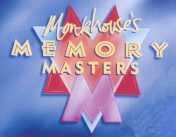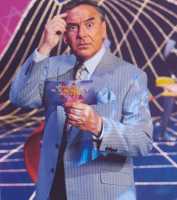Monkhouse's Memory Masters
m |
|||
| Line 46: | Line 46: | ||
== Inventor == | == Inventor == | ||
| - | Devised by Mark Channon. He appeared on the show as the on-air memory expert. He would give the three contestants two weeks' memory skills training. He gave one example of the 'link the word to familiar images' memory-tactic as thinking of Terry Wogan with a duck's tail in order to remember the word 'Pterodactyl' ('Terry Ducktail' - get it? | + | Devised by Mark Channon. He appeared on the show as the on-air memory expert. He would give the three contestants two weeks' memory skills training. He gave one example of the 'link the word to familiar images' memory-tactic as thinking of Terry Wogan with a duck's tail in order to remember the word 'Pterodactyl' ('Terry Ducktail' - get it? Well, the contestants presumably did!) |
== Theme music == | == Theme music == | ||
Revision as of 22:05, 2 September 2009

Contents |
Host
Co-hosts
Annabel Giles was the "roving reporter" for the outdoor round in each programme.
Broadcast
Action Time for BBC 1, 31 May to 19 July 1995 (8 programmes in 1 series)
Synopsis
Yes, Game Show King Bob's back and this time he's hosting a show on... uh... what was it now? Ah yes, memory. This is a bit different to Kim's game or things of that ilk, hundreds and hundreds of things had to be remembered for instant recall. Before the show, the contestants were given most of the information that would need to be recalled on the show. This information was used in many of the quick-fire rounds involved where given a piece of information, say, a name, the contestant would have to remember which town they lived in. They generally succeeded in showing some very impressive memory-skills, with plenty of arm-waving along the way as they strove to recall the relevant information!
Every contestant was given training several weeks before the show in how to improve their memory. The memory trainer-in-residence (see Inventor section below) used to come on during the show, and he'd tell the nice people at home some vague, don't-give-the-game-away background on how it was done.
 "And who's hosting this show...?" - Bob Monkhouse
"And who's hosting this show...?" - Bob MonkhouseRound 1 kicks off with the contestants recalling a long list of facts. For example, they had been given a list of 131 British towns and their associated European twin towns to memorise. Bob reads out a British town, the contestants name the twin town. Three questions for each contestant, then six questions on the buzzer.
Round 2 is memorisation on-the-fly. A voice reads out a list of fifteen numbered objects, with a common theme ("to do with films") - 1, ghost; 2, masks; 3, hairspray and so on. This is the first time the contestants had heard the list and they memorised it live. Bob then asks some easy questions like "What item is most associated with the face of the Phantom of the Opera?" - the contestants have to reply not just with the answer to the question but the number it was associated with as well. Questions on the buzzer.
The next round was filmed before the studio-based game. They would be sent to a place and asked (yes!) to memorise lots of things. In one particular example, there was a farm with about fifty donkeys in it. They had to remember the name of each donkey individually - every single one of them. Whoever did the best got the most points, and so on and so forth. Another example was a stately home with a collection of classic cars. Contestants memorised the cars' registration plates and are tested on naming the registration plate for each car. The contestants score 29/40, 36/40 and 38/40. Gulp.
Round 4 re-uses the list of fifteen numbered objects from before. Bob now reads out arithmetic sums (e.g. masks multiplied by hairspray plus Frankenstein). The contestants work out the answer and give it in code (e.g. 2 x 3 + 5 = 11 therefore Superman). Questions on the buzzer. Again.
The two losing two contestants depart stage right, but not before they get an Apple Newton each (eee, remember them?).
In the final, the winning contestant (who has previously memorised a whole Bucket-O-Information about a specialised subject) would answer the same five multi-part questions as a "real" expert in that subject. Both would be stood in soundproof booths and Bob would switch off the sound to the contestant's booth by remote control as the expert gave his/her answer. As long as they scored at least the same score, they'd win a Great Big Prize (holiday to Lanzarote) instead of an Ordinary Big Prize, ie the aforementioned Apple Newton.
Surely the masterly Bob Monkhouse can make a show about memory interesting, yes? Well, no. The problem with the show was that it was far too passive - there was only one round you could play along at home with. To make it worse, watching people sitting at a desk thinking isn't the most interesting thing you could be doing on a Monday evening. And in any case, we'd usually miss it because we'd forget it was on.
Catchphrases
He signed off every episode with the words: "Remember - don't forget!"
Inventor
Devised by Mark Channon. He appeared on the show as the on-air memory expert. He would give the three contestants two weeks' memory skills training. He gave one example of the 'link the word to familiar images' memory-tactic as thinking of Terry Wogan with a duck's tail in order to remember the word 'Pterodactyl' ('Terry Ducktail' - get it? Well, the contestants presumably did!)
Theme music
Composed by Simon Etchell.
Trivia
The show was originally titled Memory Masters and the consolation T-shirts had already been made. However, after it was decided Bob would front the show they had to redo them to put the name "Monkhouse" along the top.

